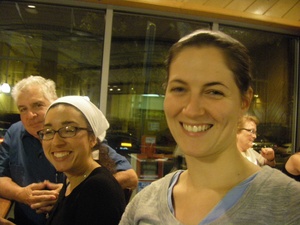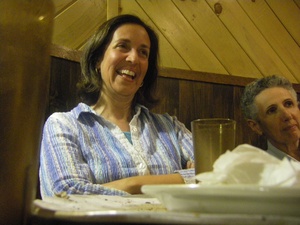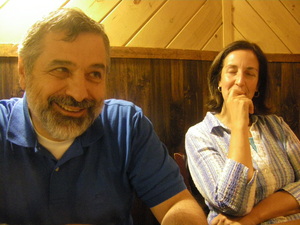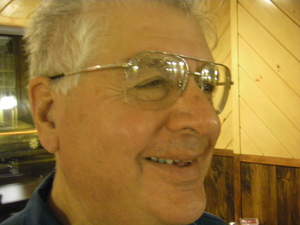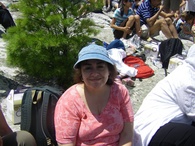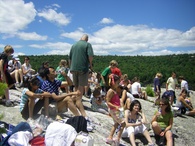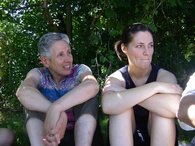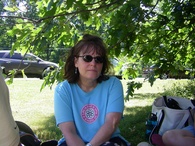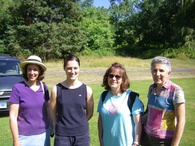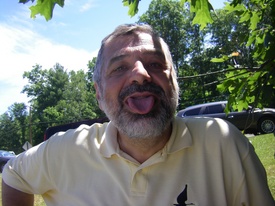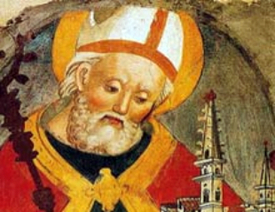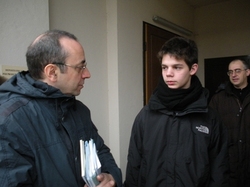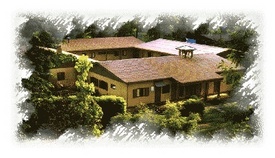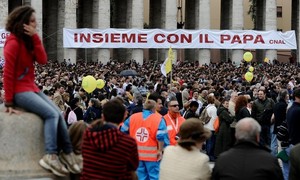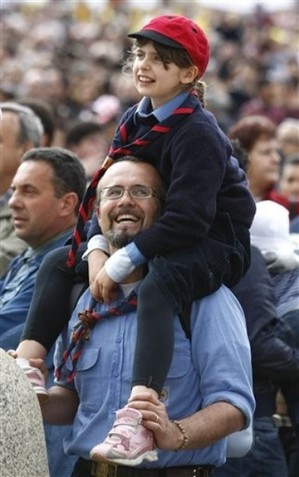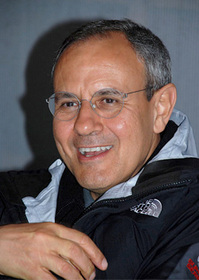Having pizza with friends in Communion & Liberation-New Haven. Following our weekly School of Community meeting we go for pizza at Modern Pizza. Yesterday was our farewell pizza with Francesca who’s returning to Italy. God’s speed, Francesca!!!
Tag: Communion and Liberation
Crossroads Cultural Center
 There are a few good opportunities to take our lives seriously. One such opportunity is the Crossroads Cultural Center that looks “to offer opportunities for education, making it possible to look with openness, curiosity and critical judgment at every aspect of reality.” Crossroads takes Saint Paul’s exhortation to “test everything; retain what is good” with
There are a few good opportunities to take our lives seriously. One such opportunity is the Crossroads Cultural Center that looks “to offer opportunities for education, making it possible to look with openness, curiosity and critical judgment at every aspect of reality.” Crossroads takes Saint Paul’s exhortation to “test everything; retain what is good” with
Follow the companionship Christ has given
“There are many companionships. I don’t say, “Choose
one,” but follow the one that Christ has put you in, that Christ has had you
meet, the one that first struck you convincingly.”
Giussani, Founder of Communion and Liberation
Communion and Liberation Vacation 2010
Scenes from the 2010 Northeast Coast Communion & Liberation Vacation in the Hudson Valley, outside New Paltz, New York, July 1-5, 2010 … Can anything make life new again?
A day at … La Cascinazza Monastery
The Benedictine monks of the Monastery of Saints Peter and Paul have captured my personal, spiritual and theological imagination. Why? Because they seem to be attentive to the “right things” in the Rule of St Benedict and they are asking the right questions when it comes to their desires. Their history and on-going life as Benedictine monks is lived in light of the charism given to the Church in Communion and Liberation is strikingly beautiful and “on target” as far as I am concerned. They, though not perfect by any means, are attentive to their humanity; the monks are are attentive to their “I”, the whole person. Plus, any group of monks to make beer (see this link for an Italian article/photos) can’t be all that bad, can they? Visit the monks’ website for their beer.
Below is the most recent article on the La Casinazza monks was published in the April issue of Traces; other articles on them con be found at the Traces webpage.
In front of Him: Silence, liturgy, work.
We spent 24 hours at the Benedictine monastery founded in 1971 on the edge of Milan, Italy. It is a place where, from bottling beer to plowing the fields, everything has value, because “it is in relation to Christ,” and contributes to generating a people-even in Japan.
by Fabrizio Rossi
“Do you see this fork? You might not even notice it. Or you might be amazed, because someone placed it on the table. Nothing can spare you from having to move: in the monastery or in any other place, you are the one that makes the difference.” The heart of this place is summed up in these words. At La Cascinazza, the Benedictine monastery in the countryside outside of Milan, supper has just finished. The iron gate that separates this farm from the pastures, the fields, and the Milanese lowlands, is closed. By reciting the “Deo gratias,” the monks have broken their silence. Out of the 24 hours of the day, “recreation” is the only moment in which they can speak freely. And each word is precious, as I have just been shown by Giorgio, who was among the first men who founded this community almost 40 years ago (today there are 15 of them, including 2 Spaniards and a Brazilian, all with diverse backgrounds). As they gather together in the chapter room at the end of a day spent in silence, a certain confusion might be expected. Instead, no one talks over the other; they speak of how the work went, or they help each other to judge certain facts, or share prayer intentions.
“It is not by chance,” explains Fr. Sergio, the Prior, “that it is in the free moments that what we care about most emerges. In any case, there is no lack of arguments…” Just like a family. Then, at 8:40 pm, all arguments must give way. As silence returns, a monk reads aloud two pages of a work by Fr. Giussani (lately, it is Qui e ora [Here and Now], a collection of dialogues with university students), before closing the day in the chapel with Compline and the singing of “Ave, Regina Caelorum” with the lights out, before the icon of the Virgin Mary.
The life of these men is like the sun rising in the world, for “it is the moment in which humanity begins to be itself,” as Fr. Giussani, who always felt close to the Benedictine experience, used to say to them. From the very beginning, he supported the vocations to the monastic life that began to spring up in the Movement, like those of the CL high school students who-having first lived at Subiaco, one of the monasteries founded by St. Benedict himself-were at the origin of La Cascinazza. These are men who are like a seed in the earth, destined to grow into a great tree-like the two cedars planted in the first years of the monastery, which now dominate the courtyard, facing the central wing of the farmhouse with the chapel on one side and, on the other, the tractor sheds.
Ora et labora. On the side, at the entrance beneath a small colonnade, is a schedule of the hours. Every day is the same: wake-up at 5:00am. At 5:15, Divine Office in the chapel. Breakfast. Lauds at 6:50. Mass at 8:30. Then work. The Angelus at noon, then Sext. Lunch. At 3:00 pm, None. Study. Some work. The Angelus again. Vespers at 7:00 pm. Then, supper, recreation, and Compline… A routine? “The point is not to be constantly doing something different,” says Rafael, from Spain. For a dozen years, he has been tending the garden, the orchard, and now also the monastery beehives. “Just as with a married couple, there is newness if they relive the fascination of the day they first met.”
It is the newness that the monks are experiencing, also ever since they began to make beer, in the old stable converted into a brewery, the result of a search that took years. Ever since they discovered that what they grew themselves was not enough to sustain them, they have tried out a number of trades, even soldering microchips.
Malt and valves. “Then a friend suggested, ‘Why don’t you try beer?'” recounts Fabrizio, 41, an architect from Alessandria, Italy. “This was a job that would allow us to maintain our rhythms, in addition to carrying on a tradition that owes a lot to monks.” So Fabrizio and Marco, an economist from Como, Italy, in 2005 traveled to a Trappist Monastery in Flanders to learn. After several attempts (“We started out in the kitchen with a pot!”), the first Italian monastic beer was born: “Amber,” to which the dark version, “Bruin,” was later added. “But the real novelty is what is happening amongst us.” In the brewery, along with Fabrizio and Marco, are Quique, who arrived from Madrid in 2000, where he was a diocesan priest, and Pietro, who entered a little over a year ago, fresh from completing medical school. So, an architect, an economist, a theologian, and a doctor… “Each of us is different from the others. But it is the work that makes us grow in communion. That is how Sergio proposed it to us: ‘Get together for one minute a week and ask yourselves why you are together.’ It is a continual discovery.” And there is no lack of struggle: “Think about the person that cleans the bathrooms,” recounts Quique, who spent the first six years armed with gloves and a cleaning rag. “It is not what you would choose… But, as Sergio said to me one day, “in obedience, everything corresponds to you even if nothing corresponds.” Sure, he needed time to understand: “Just as when I was asked to make beer. I objected for a year. ‘I studied philosophy and theology; what do I have to do with malt and valves? The most fundamental thing, however, is not to keep from rebelling, but to give in to the relationship with that You. Now I see that to face someone is worth my while.”
To face someone, in each instant. The psalm sung a few hours ago, before the world had awoken, comes to mind: “To You I cry out day and night…” Or Mass, celebrated today by Fr. Claudio-who came from the city of Varese 35 years ago and who has the task of guiding the novices-in which one by one the monks brought the intentions that relatives and friends have asked for: “For Silvia’s studies,” “For those without work,” “For Paolo and Pino’s journey in Novosibirsk,” “That Your face may illuminate the desperate…” Behind these walls, where news enters only if someone brings it, such attention to what is happening in the world-in real time-is striking, even if, apparently, not even L’Osservatore Romano or the Italian Bishops Conference newspaper ever arrive on time!
“We are here to carry the cry of each man to Christ,” explains Fr. Sergio who, in the 1970s, worked on the railroads and, hoping to respond to his own desire for meaning and for justice, threw himself into politics as a labor union activist. “The point is to be serious with one’s own question; otherwise, you can look at any tragedy and remain indifferent. It is what I told the monks this morning in the chapter, reading a letter of St. Bernard: we cannot care for others if we forget ourselves.” Hence, the value of silence: “To help each other recognize Someone present. Far from being mortification, it is what you do when faced with something beautiful: you are speechless. Imagine if Fr. Giussani lived upstairs: you would never hear the vacuum cleaner, but we would always be tensed toward his presence.”
We are interrupted by the bell for lunch. It rings seven times a day just for prayers. And it reminds everyone of the same thing: “It is the Mystery calling. Perhaps you were in your cell, meditating on a wonderful text, and then the bell rings and you are provoked to look at something even greater.” On the way to the refectory, we pass a painting by Letizia Fornasieri: two sunflowers on a table. It is like an offering on the altar: “This is why we are here. And those sunflowers remind us that even eating is a liturgy.” In fact, when the horseshoe-shaped table is full, with the Prior at the center, the food is blessed. Today, there is tomato pasta along with a potato and walnut soufflé, thanks to Pippo, an architect who has lived here since 1985. While the other monks pass the dishes in silence, one of them reads aloud a passage from the Bible or from the Rule, along with other texts for meditation (for the record, today it is Fr. Claudio’s turn, and the texts are some articles from the latest issue of Traces). Everything is for the glory of God. Whether you eat, whether you drink…
Even a coffee. St. Benedict had not foreseen it, but even this is part of his “welcome guests as you would Christ.” The Prior offers it to us after lunch. And, in the meantime, he tells us the story of this place, about the two who had been CL high school students and how in 1968 they entered the monastery of Subiaco, about those who weren’t accepted in 1970, about the esteem of the Abbot-President of Subiaco, Gabriel Brasó, for the experience of those young men and Fr. Giussani. And about this farm south of Milan, discovered by their mutual friend, Paolo Mangini, that would be the place for the monastery, born as a result of all these factors and the proposal of a new community. The proposal came from Bernardo Cignitti, an abbot from Savona who, on the heels of the Council and the exhortations of Paul VI, was deeply concerned about the rebirth of the Benedictine experience: “God writes straight with crooked lines,” comments Bruno, one of the young men not accepted at Subiaco, who 40 years ago was a book binder and now does the same thing in La Cascinazza. On June 29, 1971 (Feast of Ss. Peter and Paul, to whom the monastery is dedicated), eight monks attended the Mass that inaugurated La Cascinazza. During the homily Fr. Cignitti said, “I offer my life as fertilizer for this community.” In September he died of a tumor. “For us, the relationship with Fr. Giussani was fundamental, above all in those years,” remembers Fr. Sergio. “He always repeated to us that at the center of monastic experience there is no particular practice other than Baptism: if Christ is everything for me, He is for everyone.” In the 1980s, the relationship with the Cardinal Archbishop of Milan, Carlo Maria Martini, was also decisive. He granted recognition to the community and in 1990 erected it as a Priory sui iuris according to diocesan law.
The shadow of the moon. With time, a whole host of relationships has been added to these ones, relationships one would least expect, like the Buddhist monks from Mount
Koya in Japan who come to visit them annually, and like the friendship with the American painter William Congdon. Two of his paintings of La Cascinazza by night are hanging on the walls: “The monastery represents the self. The moon is the Mystery present, which illuminates it. From there, the shadow cast onto the courtyard-because out of that relationship a people is born.” In 1959, after a long quest, Bill-as they all refer to him-met the faith, and lived the last 20 years of his life in a small house on the monastery grounds. “He was like one of us: a wounded man, facing the Mystery.”
A wounded man. But a man in relation with that You. Or, precisely because he was in relationship with that You: “When you fall in love, you are restless until you see that woman again,” explains Rafael. “You miss her, precisely because she exists. She is part of you. That is why we experience nostalgia to the extreme: we are wounded because He exists.”
Time is up. The monks have to return to work. As I pass by the two sunflowers, only one sound breaks the silence: silverware. In the refectory, someone is setting the table.
St Peter is the “absolute and reliable rock,” Fr Giussani told us
Today in Rome members of the various Catholic lay ecclesial movements
like Focolare, Sant’Egidio, Catholic Action and Communion and Liberation are
gathering in Rome as a sign of prayerful solidarity at the Regina Coeli address
of the Pope in Saint Peter’s Square. Indeed, in a sign of friendship and
obedience to the Successor of Saint Peter, Pope Benedict XVI. And as a sign of
this worldwide communion with the Pope, members of Communion and Liberation are
gathering in cities around the world in prayer for the Pope and the Church.
According to news about the event, about 150,000 people flooded Saint Peter’s Square. The Pope said that he was comforted by the “beautiful and spontaneous show of faith and solidarity.”
Here in New York, for example, CL is attending the Mass at Saint Patrick’s
Cathedral with Archbishop Timothy Dolan and will pray the rosary together.
To
understand these pious and fraternal gestures of CL, here are some thoughts of
Monsignor Luigi Giussani that may give a fuller appreciation of the
companionship of faith and brotherhood we all share.
Christianity is an
irreducible event, an objective presence that desires to reach man; until the
very end, it means to be a provocation to him, and to offer a judgment of him.
Jesus said to the Apostles after his Resurrection, “Behold, I am with you always,
even to the end of the world” (Mt 28:20).
Christianity will have a dramatic and
decisive bearing on man’s life only if it is understood in accordance with its
originality and its factual density, which, two thousand years ago, had the
form of a single man. Yet even when He was still living, he also had the face
of people whom he had brought together, and then sent out two by two, to do
what He had been doing, and what he had told them to do; they came back
together and returned to him. Later, united as one, this people went out to the
entire known world to present that Fact. The face of that single man today is
the unity of believers, who are the sign of him in the world, or as Saint Paul
says, who are his Body, his mysterious Body – also called “the people of God” –
guided and guaranteed by a living person, the Bishop of Rome.
If the Christian
fact is not recognized and grasped in its proper originality, it becomes
nothing more than a ponderous occasion for all sorts of interpretations and
opinions, or perhaps even for works; but then it lies alongside of or more
often subordinate to all of life’s other promptings.
(Religious Awareness in
Modern Man, Communio, vol. XXV, n.1, Spring 1998, pp. 134-135)
The supreme
authority is the one in which we find the meaning of all our experience. Jesus
Christ is this supreme authority, and it is His Spirit who makes us understand
this, opens us up to faith in Him and His person. “Just as the Father has sent
me so do I send you.” (See John 20:21) The apostles and their successors (the
Pope and the bishops) constitute, in history, the living continuation of the
authority who is Christ. In their dynamic succession in history and their
multiplication throughout the world, Christ’s mystery is proposed ceaselessly,
clarified without errors, defended without compromise. Therefore, they
constitute the place, like a reliable and effervescent spring, where humanity
can draw on the true meaning of its own existence, probing ever deeper.
What
genius is to the cry of human need, what prophecy is to our cry of expectancy,
so the apostles and their successors are to announcing the response. But just
as the true answer is always perfectly specific and concrete with respect to
the expectancy which is inevitably vague and subject to illusions – so are
they, like an absolute and reliable rock, infallible: “You are Peter and on
this rock I shall build my Church.” (Matthew 16:17ff.)
Their authority not only
constitutes the sure criterion for that vision of the universe and history that
alone explains their (i.e., the universe’s and history’s) meaning; it is also
vital – it steadfastly stimulates a true culture and persistently points to a
total vision. It inexorably condemns any exaltation of the particular and
idealization of the contingent; that is, it condemns all error and idolatry.
The authority of the Pope and bishops, therefore, is the ultimate guide on the
pilgrimage towards a genuine sharing of our lives [convivenza], towards a true
civilization.
Where that authority is not vital and vigilant, or where it is
under attack, the human pathway becomes complicated, ambiguous, and unstable;
it veers towards disaster, even when on the exterior it seems powerful,
flourishing, and astute, as is the case today. Where that authority is active
and respected, the historic pilgrimage is confidently renewed with serenity; it
is deep, genuinely human, even when the expressive methods and dynamics of
sharing lives are roughshod and difficult.
Still today it is the gift of the
Spirit that allows us to discover the profound meaning of Ecclesiastical
Authority as a supreme directive on the human path. Here is the origin of that
ultimate abandonment and of that conscious obedience to it – this is why it is
not the locus of the Law but of Love. One cannot understand the experience of
that definitive devotion that binds the “faithful” to Authority without taking
into consideration the influence of the Spirit, and that devotion often affirms
itself on the Cross of a mortification of the drive of our own genius or our
plans for life.
(The Journey to Truth Is an Experience, Montreal:
McGill-Queen’s University Press 2006, pp. 73-75)
“Why I am a Catholic?” is a good question to ask
McGill University professor of History John Zucchi, Canada’s national leader for Communion and Liberation, asks the provocative question in a brief essay, “Why I am a Catholic.” John is a great guy, he’s serious about his faith and he’s sensitive to the movement of the Holy Spirit, but no one would claim he’s a mediocre follower of Christ. The claims of faith in Christ, Zucchi tells us, have to have two criteria borrowing from Luigi Giussani: faith in Christ has to be reasonable and it has to broaden my humanity, a gift given by God Himself. Reason and humanity lead to and exude Mercy. Paraphrasing Cardinal Ratzinger in God and the World, to be a Christian means that you are sympathetic toward one’s humanity that of another; a Christian is accepting of one’s injuries and within these wounds a deeper healing is found.
A new Vatican office: Pontifical Council for the New Evangelization?
Writing for il Giornale.it today, veteran vaticanista Andrea Tornielli, speaks of a new pontifical council to be created specifically for the work of the new evangelization, a term coined by Pope John Paul II in 1979 while visiting the Poland’s Nowa Huta. Pope Benedict is expected to release an Apostolic Letter soon. The idea comes to fruition because of the diligence of Venice’s cardinal-archbishop, Angelo Scola, and Josef Cordes and the inspiration of Monsignor Luigi Giussani, founder of the Fraternity of Communion and Liberation. A new council with this work is seen as keenly central to the work of Benedict’s papacy. The first head of the new council is expected to be according to Tornielli, Archbishop Rino Fisichella, the current head of the Pontifical Academy of Life and the rector of the Lateran University.
Recognizing what Pope Benedict has done for the Church … Julián Carrón
This coming Monday is the fifth anniversary of the election
of Pope Benedict XVI. Communion and Liberation is encouraging people to attend
Mass, pray a Rosary, or attend Eucharistic Adoration on that day to pray for
the Holy Father, in thanksgiving for his witness to Christ.
The following
letter is from Father Julián Carrón, the President of Communion and Liberation,
sent to the Italian newspaper La Repubblica (April 4, 2010).
Let Us Return,
Wounded, to Christ
Father Julián Carrón
None of us has ever been as dismayed
as we are in front of the heart-wrenching story of child abuse. Our dismay
arises from our inability to respond to the demand for justice which springs
from the bottom of our hearts.+The request to assume responsibility, the
acknowledgement of the evil committed, the reprimand for the mistakes made in
the handling of the affair – all of this seems to us to be totally inadequate
as we face this sea of evil. Nothing seems to be enough. And so we can
understand the frustrated reactions that have been coming forth at this time.
This
has all served the purpose of making us stand face to face with our demand for
justice, acknowledging that it is limitless, bottomless – as deep as the wound
itself. Since it is infinite, it can never be satisfied. So the
dissatisfaction, impatience and even the disillusionment of the victims are
understandable, even after all the injuries and mistakes have been admitted:
nothing can satisfy their thirst for justice. It’s like entering into an
endless struggle. From this point of view, the ones who committed the abuse are
paradoxically facing a challenge similar to that of the victims: nothing can
repair the damage that has been done. This in no way means that their
responsibility can be lifted, and much less the verdict that justice may impose
upon them; it would not be enough even if they were to serve the maximum
sentence.
If this is the case, then the most burning question, which no one can
escape, is as simple as it is unavoidable: “Quid animo satis?” What can satisfy
our thirst for justice? This is where we begin to feel all our powerlessness,
so powerfully expressed in Ibsen’s Brand: “Answer me, God, in the jaws of
death: Is there no salvation for the Will of Man? No small measure of
salvation?” In other words, cannot the whole force of human will succeed in
bringing about the justice that we so long for?
This is why even those who
demand it most, those who are most insistent in calling for justice, will not
be loyal to the depth of their nature with its demand for justice if they do
not face this incapacity that they share with all men. Were we not to face it,
we would fall prey to an even crueler injustice, to a veritable assassination
of our humanity, because in order to keep on crying out for the justice that we
formulate according to our own measurement, we have to silence the voice of our
hearts, thus forgetting the victims and abandoning them in their struggle.
It
is the Pope who, paradoxically, in his disarming boldness, has not fallen prey
to reducing justice to any sort of human measure. To begin with, he admitted without
hesitation the gravity of the evil committed by priests and religious, urged
them to accept their responsibility for it, and condemned the way certain
bishops in their fear of scandal have handled the affair, expressing his deep
dismay over what had happened and taking steps to ensure that it not happen
again. But then, he expressed his full awareness that this is not enough to
respond to the demand that there be justice for the harm inflicted: “I know
that nothing can undo the wrong you have endured. Your trust has been betrayed
and your dignity has been violated.” Likewise, even if the perpetrators serve
their sentences, repent, and do penance, it will never be enough to repair the
damage they did to the victims and to themselves.
Benedict XVI’s recognition of
the true nature of our need, of our struggle, is the only way to save our full
demand for justice; it is the only way to take it seriously, to take it fully
into consideration. “The demand for justice is a need that is proper to man,
proper to a person. Without the possibility of something beyond, of an answer
that lies beyond the existential modalities that we can experience, justice is
impossible… If the hypothesis of a ‘beyond’ were eliminated, that demand would
be unnaturally suffocated” (Father Giussani).
So how did the Pope save this
demand? By calling on the only one who can save it, someone who makes the
beyond present in the here and now, namely, Christ, the Mystery made flesh.
“Jesus Christ … was Himself a victim of injustice and sin. Like you, He still
bears the wounds of His own unjust suffering. He understands the depths of your
pain and its enduring effect upon your lives and your relationships, including
your relationship with the Church.”
Calling on Christ is not a way to seek a hiding
place to run off to in the face of the demand for justice: it is the only way
to bring justice about. The Pope calls upon Christ, and steers clear of a truly
dangerous shoal, that of distancing Christ from the Church, as if the Church
were too full of filth to be able to bear Him. The Protestant temptation is
always lurking. It would have been very easy to give in to, but at too high a
price – that of losing Christ. Because, as the Pope recalls, “it is in the
communion of the Church that we encounter the person of Jesus Christ.” And so,
aware of the difficulty both the victims and the guilty have “to forgive or be
reconciled with the Church,” he dares to pray that, by drawing near to Christ
and sharing in the life of the Church, they “will come to rediscover Christ’s
infinite love for each one of you,” since He is the only one able to heal their
wounds and rebuild their lives.
This is the challenge facing all of us who are
incapable of finding an answer for our sins and for the sins of others: agreeing
to take part in Easter, which we celebrate during these days, as the only way
to see the re-blossoming of hope.
MedConference: Medical Care and the Person: The Heart of the Matter
 The MedConference is a three-day medical conference open to physicians, nurses and students of medical and nursing schools.
The MedConference is a three-day medical conference open to physicians, nurses and students of medical and nursing schools.
